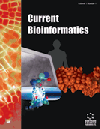- Home
- A-Z Publications
- Current Bioinformatics
- Previous Issues
- Volume 19, Issue 10, 2024
Current Bioinformatics - Volume 19, Issue 10, 2024
Volume 19, Issue 10, 2024
- Life Sciences, Systems Biology & Bioinformatics, Biochemical Research Methods, Mathematical & Computational Biology
-
-
-
Advances in Deep Learning Assisted Drug Discovery Methods: A Self-review
More LessAuthors: Haiping Zhang and Konda Mani SaravananArtificial Intelligence is a field within computer science that endeavors to replicate the intricate structures and operational mechanisms inherent in the human brain. Machine learning is a subfield of artificial intelligence that focuses on developing models by analyzing training data. Deep learning is a distinct subfield within artificial intelligence, characterized by using models that depict geometric transform Read More
-
-
-
-
A-RFP: An Adaptive Residue Flexibility Prediction Method Improving Protein-ligand Docking Based on Homologous Proteins
More LessAuthors: Chuqi Lei, Senbiao Fang, Yaohang Li, Fei Guo and Min LiBackgroundComputational molecular docking plays an important role in determining the precise receptor-ligand conformation, which becomes a powerful tool for drug discovery. In the past 30 years, most computational docking methods have treated the receptor structure as a rigid body, although flexible docking often yields higher accuracy. The main disadvantage of flexible docking is its significantly higher computational Read More
-
-
-
STNMDA: A Novel Model for Predicting Potential Microbe-Drug Associations with Structure-Aware Transformer
More LessAuthors: Liu Fan, Xiaoyu Yang, LeiWang and Xianyou ZhuIntroductionMicrobes are intimately involved in the physiological and pathological processes of numerous diseases. There is a critical need for new drugs to combat microbe-induced diseases in clinical settings. Predicting potential microbe-drug associations is, therefore, essential for both disease treatment and novel drug discovery. However, it is costly and time-consuming to verify these relationships through traditional w Read More
-
-
-
Genotype and Phenotype Association Analysis Based on Multi-omics Statistical Data
More LessAuthors: Xinpeng Guo, Yafei Song, Dongyan Xu, Xueping Jin and Xuequn ShangBackgroundWhen using clinical data for multi-omics analysis, there are issues such as the insufficient number of omics data types and relatively small sample size due to the protection of patients' privacy, the requirements of data management by various institutions, and the relatively large number of features of each omics data. This paper describes the analysis of multi-omics pathway relationships using statistical data in t Read More
-
-
-
Enhancing Drug-Target Binding Affinity Prediction through Deep Learning and Protein Secondary Structure Integration
More LessAuthors: Runhua Zhang, Baozhong Zhu, Tengsheng Jiang, Zhiming Cui and Hongjie WuBackgroundConventional approaches to drug discovery are often characterized by lengthy and costly processes. To expedite the discovery of new drugs, the integration of artificial intelligence (AI) in predicting drug-target binding affinity (DTA) has emerged as a crucial approach. Despite the proliferation of deep learning methods for DTA prediction, many of these methods primarily concentrate on the amino acid sequence of Read More
-
-
-
Sia-m7G: Predicting m7G Sites through the Siamese Neural Network with an Attention Mechanism
More LessAuthors: Jia Zheng and Yetong ZhouBackgroundThe chemical modification of RNA plays a crucial role in many biological processes. N7-methylguanosine (m7G), being one of the most important epigenetic modifications, plays an important role in gene expression, processing metabolism, and protein synthesis. Detecting the exact location of m7G sites in the transcriptome is key to understanding their relevant mechanism in gene expression. On the basis of experim Read More
-
-
-
Integrated Machine Learning Algorithms for Stratification of Patients with Bladder Cancer
More LessAuthors: Yuanyuan He, Haodong Wei, Siqing Liao, Ruiming Ou, Yuqiang Xiong, Yongchun Zuo and Lei YangBackgroundBladder cancer is a prevalent malignancy globally, characterized by rising incidence and mortality rates. Stratifying bladder cancer patients into different subtypes is crucial for the effective treatment of this form of cancer. Therefore, there is a need to develop a stratification model specific to bladder cancer.PurposeThis study aims to establish a prognostic prediction model for bladder cancer, with the primary Read More
-
-
-
CFCN: An HLA-peptide Prediction Model based on Taylor Extension Theory and Multi-view Learning
More LessAuthors: Bing Rao, Bing Han, Leyi Wei, Zeyu Zhang, Xinbo Jiang and Balachandran ManavalanBackgroundWith the increasing development of biotechnology, many cancer solutions have been proposed nowadays. In recent years, Neo-peptides-based methods have made significant contributions, with an essential prerequisite of bindings between peptides and HLA molecules. However, the binding is hard to predict, and the accuracy is expected to improve further.MethodsTherefore, we propose the Crossed Fe Read More
-
Volumes & issues
-
Volume 20 (2025)
-
Volume 19 (2024)
-
Volume 18 (2023)
-
Volume 17 (2022)
-
Volume 16 (2021)
-
Volume 15 (2020)
-
Volume 14 (2019)
-
Volume 13 (2018)
-
Volume 12 (2017)
-
Volume 11 (2016)
-
Volume 10 (2015)
-
Volume 9 (2014)
-
Volume 8 (2013)
-
Volume 7 (2012)
-
Volume 6 (2011)
-
Volume 5 (2010)
-
Volume 4 (2009)
-
Volume 3 (2008)
-
Volume 2 (2007)
-
Volume 1 (2006)
Most Read This Month
Article
content/journals/cbio
Journal
10
5
false
en


